Hand-raising baby guinea pigs can be quite tricky and demanding. This responsibility should never be taken on lightly, and some points should be considered before deciding to hand-raise guinea pigs.
Most importantly, you need to be 100% confident that the mother guinea pig isn’t feeding her babies. Unless the mother guinea pig is known to be dead, there is a good chance that she is in fact feeding her babies. In general, mother guinea pigs do not constantly tend to their babies the way we might think.
Guinea pig mothers feed their babies only a few times per day and then leave them alone to their own devices. Guinea pigs are born being able to walk, see and hear, and most of them will start nibbling on solids within a few days, as well as drink milk from their mum.
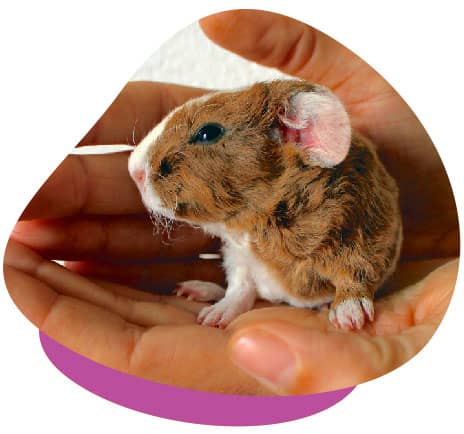
Signs That Baby Guinea Pigs Have Been Neglected From Their Mother
If you think the mother guinea pig is “ignoring” her litter, have a look at the condition of the babies. If the baby’s tummies are round and full-looking, they are active and bright, warm and chatting away, making little noises, then the mother guinea pig is likely feeding them.
If the babies are cold, lethargic or have shrunken bellies, then you may have to intervene. It is a good idea to weigh the babies daily to make sure they are growing and gaining weight appropriately.
Handling Baby Guinea Pigs
Before handling the babies, wash your hands well. This not only helps to remove bacteria but also eliminates any smells from other objects or animals that can stress the babies. Once they’re clean, rub your hands in some clean, fresh hay and on the mother guinea pig’s fur to scent your hands.

Assisted Feeding
Before starting any syringe or bottle-feeding, it is worth trying to assist the babies with natural feeding.
If the mother guinea pig will tolerate it and isn’t too stressed, you can try to gently, but firmly hold the mother guinea pig in your arms and gently try to put each baby onto one of her nipples to self-feed. Sometimes it is helpful for the babies if a small amount of milk is expressed from the nipple to entice the baby to suckle. If you still don’t have any luck, then you may need to start to assist feeding or hand-raising.
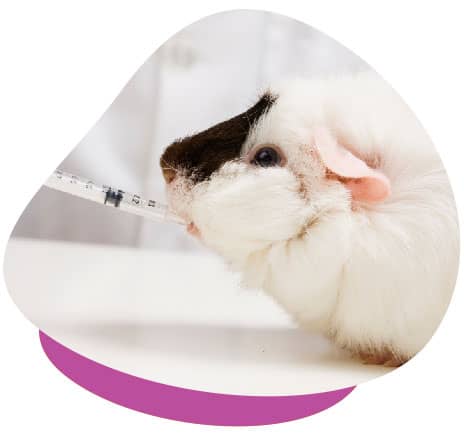
What Formula Should I Feed Baby Guinea Pigs?
We recommended the Wombaroo Guinea Pig Milk. It is a premium product that contains vitamin C (which is very important for young guinea pigs). It comes as a powder which can be mixed with warm water to make the milk for the babies. All the mixing instructions are on the box.
Wombaroo Guinea Pig Milk can be purchased from The Unusual Pet Vets. Alternatively, some other veterinary clinics and larger pet shops may also stock it.
Do I Need Additional Feeding Supplies?
In addition to the feeding formula, you will also need some small plastic syringes for feeding the milk to the babies. These can be purchased from our clinics or most pharmacies. You can also buy small plastic feeding bottles and plastic teats from large pet shops, but you will need to buy the smallest teat possible, as usually the puppy and kitten ones are generally too big. Most baby guinea pigs will feed from a syringe without a problem.
We recommend having a small scale to weigh the baby guinea pigs and for daily weight monitoring. The amount of milk to feed is dependent on the baby’s weight.
On the Wombaroo Guinea Pig Milk box, there is a weight chart and the number of mls of milk to be fed over 24 hours. Depending on how much the baby guinea pig will take in one feeding session will depend on how frequently you have the feed them.
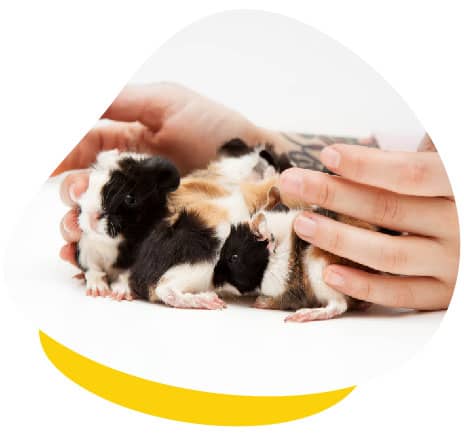
Feeding Procedure
Step 1
Make sure all your syringes and bottles have been thoroughly washed before use.
Step 2
Baby guinea pigs are wiggly and unpredictable. They jump suddenly and unexpectedly. A drop of only one or two feet can be fatal, so make sure they are being fed and kept in a safe environment.
Step 3
Hold the baby in its normal sitting position in one hand, and the bottle/syringe in the other. Otherwise, have the baby guinea pig sitting (safely) on the floor or a table and feed with the bottle/syringe slightly vertically in front.
Step 4
Babies often resist feeding at first, and you must overcome the temptation to force-feed. If the baby doesn’t accept the teat or syringe, then wet the baby’s lips with a drop of warm formula so it licks it off. Once it has swallowed that, repeat the procedure over and over. Be persistent and gentle. The baby will soon learn about feeding time and will generally learn to take the formula willingly despite not doing this on the first feeding.
Step 5
Do not be too forceful and squeeze too much formula into the baby guinea pig’s mouth. They can inhale milk quite easily, so drip the formula slowly for the baby to lick up.
Step 6
If the baby grabs the teat and begins suckling, allow him to do so without adding any pressure yourself. The baby should be able to suckle with enough strength to empty the bottle or syringe without any help from you. If you provide extra force, the baby may accidentally aspirate formula that’s coming in too fast.
Step 7
If the babies do not suckle, it’s not a significant problem. Most will learn to lap or sip from the tip of the teat, and this is safer, in reducing the risk of aspiration. Try to hold the teat or syringe tip sideways or down-pointed, relative to the mouth, to further reduce the risk of aspiration.
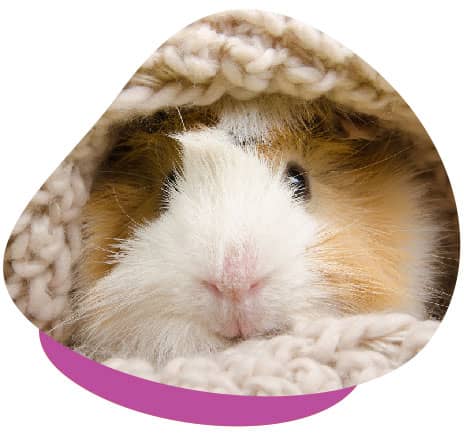
Do Baby Guinea Pigs Need to Be Kept Warm?
It is best to keep the babies in a warm, quiet place and in a small box or carry cage. For heating, two or more babies usually snuggle to keep each other warm. However, if there’s only one baby, a warm water bottle or heat pack wrapped in a soft towel can provide an excellent heat source but be sure the guinea pig can crawl away from the heat if it gets too warm.
A Tip on Toileting
Many newborn mammals cannot urinate or defecate on their own. Most baby guinea pigs will require the stimulation of the mother’s grooming tongue on their bellies and genital region to release a stream of urine and faeces.
To mimic this behaviour use a cotton ball moistened with warm water, and gently tap or rub the urogenital area until you feel the baby’s abdominal muscles tense and a stream of urine is released. Getting a urination response may take 15-20 seconds of stimulation, or even more.
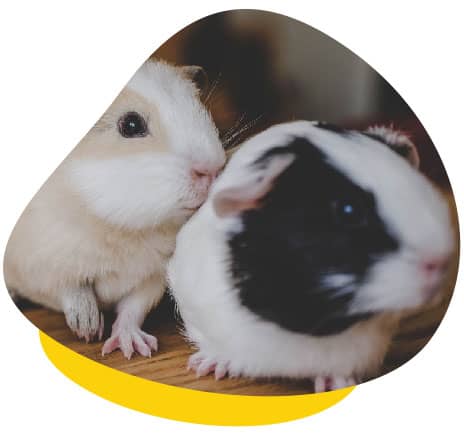
When Are Baby Guinea Pigs Weaned?
A mother guinea pig generally feeds her babies for about 3-4 weeks, gradually decreasing the frequency of feedings until they lose interest. Your baby guinea pigs will start to nibble solid food from only a few days old. You can start introducing them to timothy and oaten hay, pellets, as well as small amounts of green vegetables and water in a shallow dish from when they are born, but this does not mean they are ready to be weaned. Once they start to eat solid foods it is even more critical that you continue the feeding formula to help control the growth of potentially harmful pathogens as the babies introduce new bacteria into their systems.
If the babies still beg for nursing by the age of 5 – 6 weeks, you can begin to dilute the formula with clean drinking water. Start with 25% water to 75% formula, and gradually decrease the percentage of milk until the babies lose interest.
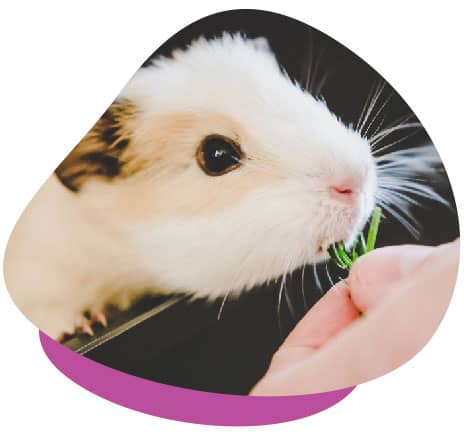
Should the Male and Female Baby Guinea Pigs Be Separated?
Male and female baby guinea pigs should be separated from each other at 3-4 weeks of age to prevent any early pregnancies. Guinea pigs can then be sterilised from 16 weeks.
At What Age Can Baby Guinea Pigs Be Re-homed?
Baby guinea pigs can then be rehomed to new families by eight weeks of age, as long as fully weaned and eating solids well on their own. It is a good idea to have the babies examined by a guinea pig vet prior to sending them off to their new forever home.
For more information on hand-raising baby guinea pigs, contact your local Unusual Pet Vets team.

